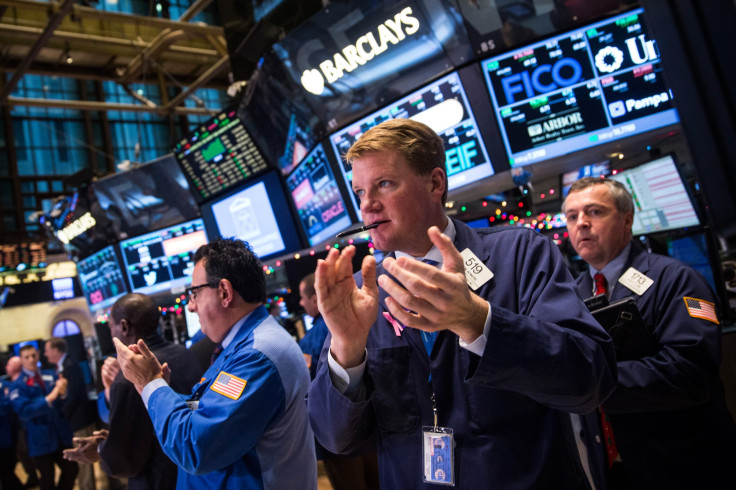The Stock Market Is Approaching Record Highs. So What’s Behind The Rally?

Like a boxer who gets knocked down but rises up again, the U.S. stock market has lifted itself out of the deep slump it suffered at the start of the year to rally toward near-record highs in recent days. The Standard & Poor’s 500 inched further past the 2,100 milestone Wednesday as the Dow Jones Industrial Average pushed above 18,100.
But the upsurge in stock prices has been just as notable for what’s missing. Namely, corporate earnings, which are projected to have moved downward for a sixth straight quarter. As major companies begin reporting financials for a challenging start to the year, it’s unlikely that the trend will snap very soon.
So if companies aren’t making as much money, what’s driving the rally in stocks? The answer, in part, is the same forces that drove a massive sell-off in the volatile first six weeks of the year: China and the U.S. dollar.
“This is a reversal of panic at the start of the year,” Anthony Valeri, vice president of investment strategy at LPL Financial, said. “The economic data didn’t bear out the extreme pessimism.”
That pessimism stemmed from a raft of distressing economic data out of China in the early weeks of 2015, which spurred market volatility the world over. The strengthening of the U.S. dollar against other currencies weighed on profit prospects as oil continued plummeting early in the year, deepening the pain in the energy industry.
But those trends have stabilized since U.S. markets hit a low point in the second week of February. The dollar has eased down 5 percent for the year, a relief for exporters and manufacturers. Above it all, the Federal Reserve has maintained a loose monetary policy, affirming the need for further gains across the economy.
Does the current earnings drought really matter then? Maybe not so much. “What’s supporting the market recently is overseas events,” Valeri said. The end of the oil slump and the easing of the dollar are expected to bolster earnings in upcoming quarters, he said, noting that earnings grew at a decent clip in 2015 if you exclude the energy sector and companies affected sharply by the exchange rate.
“Outside of those two sectors of the economy, we’re in pretty good shape,” Valeri said.
Still, fundamental doubts over the strength of the rally remain. With growth slowing across housing, spending and exports, the market remains in a “delicate balance,” Deutsche Bank analysts said in a recent note. “Sentiment could reverse if the Fed is seen as closer to raising rates, or if, at the other extreme, growth stutters, oil sells off, political risk escalates in Europe or China concerns re-emerge.”
For institutional investors, which include pension fund managers and insurance companies, the risks have been too high to dip into the recent rally. As Bank of America Merrill Lynch reported Tuesday, the bank’s biggest clients have been net sellers of stocks for the past 12 weeks. “Persistent sales suggest to us that clients continue to doubt the market rally,” the analysts, Jill Carey Hall and Savita Subramanian, wrote.
The fact that stocks are going up means that someone is buying, however. The buyers fall largely in three categories.
First, as JPMorgan Chase analysts said in a recent note, hedge funds have been rushing to cover short positions they entered back when recession fears were mounting. To cover the shorts, which are bets that stocks will fall, fund managers have been forced to buy up the stocks they’d previously wagered against. That buying drives demand higher.
There’s also retail investors. As the market picked up last month, individual investors increased the share of their portfolios devoted to stocks to 64 percent, compared with a long-term average of 60 percent, according to the American Association of Individual Investors.
Finally, there’s corporations themselves. Goldman Sachs analysts led by chief U.S. equity analyst David Kostin projected this week that stock buybacks will be the “key source of equity inflow” in 2016. Though repurchases are predicted to total $450 billion this year, short of the $561 billion last year, Goldman said that total would likely eclipse inflows from foreign and domestic investors of all stripes.
Companies repurchase their own shares as a way of delivering payouts to shareholders, reducing stock dilution from executive compensation and concentrating ownership amongst large shareholders. “With the U.S. economy expected to grow at a modest 2 percent pace and cash balances at high levels, firms are likely to continue to pursue buybacks as a means of generating shareholder value,” Goldman wrote.
Are those three groups — retail investors, hedge funds and corporate finance officers — enough for the S&P 500 and Dow Jones to set new records in the coming weeks? LPL’s Valeri isn’t so sure.
“We remain a little skeptical that equities will break into new highs,” he said. “It’ll take better news to do that.”
© Copyright IBTimes 2024. All rights reserved.






















